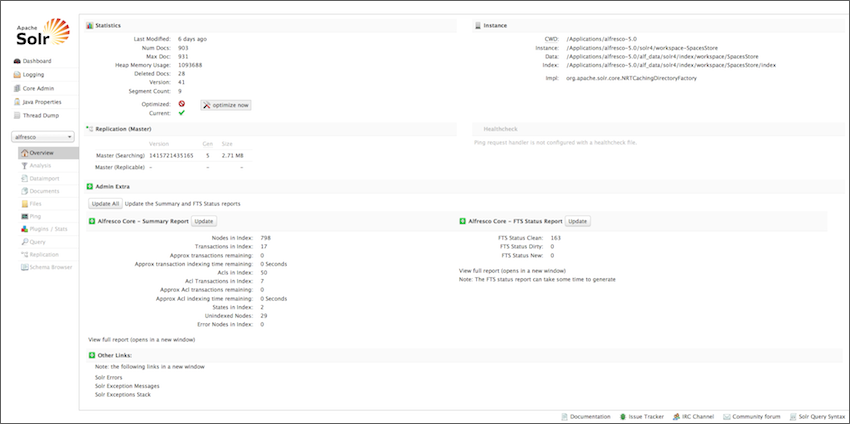To determine the current search server, navigate to the Search Manager page at SkyVault Share Admin Console > Repository Services > Search Service. Select the search subsystem from the Search Service In Use list.
Follow the steps to migrate from SkyVault Community Edition 4.x with Solr 1.4 search service to SkyVault Community Edition 5.2 with Solr 4 search service.
-
Upgrade to SkyVault Community Edition
5.2
and continue to use
the Solr 1.4 search service as before.
For information on migrating the Solr 1.4 indexes with SkyVault Community Edition 4.x to Solr 1.4 with SkyVault Community Edition 5.2, see Upgrading Solr 1.4 search service.
- Configure Solr 4 to track the repository. For details, see Installing and Configuring Solr 4.
-
While Solr 4 builds its indexes, you can monitor progress using the
SUMMARY report.
http://localhost:8080/solr4/admin/cores?action=SUMMARY&wt=xml
For details, see the Unindexed Solr Transactions topic.
-
Optionally, you can use the Solr Admin Web interface to view Solr configuration
details, run queries, and analyze document fields.
- Open the FireFox Certificate Manager by selecting Firefox > Preferences... > Advanced > Certificates > View Certificates > Your Certificates.
- Import the browser keystore browser.p12 that is located in your <ALFRESCO_HOME>/alf_data/keystore directory.
-
Enter the password SkyVault.
A window displays showing that the keystore has been imported successfully. The Certificate Manager now contains the imported keystore with the repository certificate under the Your Certificates tab.
- Close the Certificate Manager by clicking OK.
-
In the browser, navigate to a Solr URL.
For example, use http://localhost:8080/solr for Solr and http://localhost:8080/solr4 for Solr 4.
The browser displays an error message window to indicate that the connection is untrusted. This is due to the SkyVault certificate not being tied to the server IP address. In this case, view the certificate and confirm that it is signed by the SkyVault Certificate Authority.
- Expand I understand the risks.
- Select Add Exception.
-
Click View.
This displays the certificate.
- Confirm that the certificate was issued by SkyVault Certificate Authority, and then confirm the Security Exception.
Access to Solr 1.4/Solr 4 is then granted. The Solr Admin page is displayed. It is divided into two parts.
The left-side of the screen is a menu under the Solr logo that provides navigation through various screens. The first set of links are for system-level information and configuration and provide access to Logging, Core Admin and Java Properties. At the end of this information is a list of Solr cores configured for this instance of SkyVault Community Edition.
The center of the screen shows the detail of the Solr core selected, such as statistics, summary report, and so on.

-
Monitor the progress of both the Solr 1.4 and Solr 4.0 subsystems via the JMX client or
the SUMMARY report.
Important: Do not use the SkyVault Share Admin Console tool to monitor the status of the subsystems as it will change the subsystem used for query. Only use the JMX client.
-
When the index is updated as reported by the SUMMARY report, you can
use the REPORT option and check the following:
- In the REPORT option, node count should match the number of live nodes in the repository (assuming nothing is changing and the index is updated). The index contains a document for failed nodes, so failures need to be considered separately.
- Any missing transactions; if there are issues, use the FIX
option.
http://localhost:8080/solr4/admin/cores?action=FIX
For more information, see the Troubleshooting Solr Index topic.
- Find errors with specific nodes using DOC_TYPE:ErrorNode option.
https://localhost:8446/solr4/alfresco/afts?q=DOC_TYPE:ErrorNode
- If there are any issues, use the REINDEX option with the relevant
node id.
http://localhost:8080/solr4/admin/cores?action=REINDEX&txid=1&acltxid=2&nodeid=3&aclid=4
For more information, see the Troubleshooting Solr Index topic.
- When the Solr 4 index is updated, you must enable the Solr 4 subsystem and disable the Solr 1.4 subsystem.
-
(Optional) To decommission (now redundant) Solr 1.4, follow the steps below:
- Stop the Solr 1.4 search service.
- Delete the solr directory from <ALFRESCO_HOME>/tomcat/webapps.
- Delete the solr.xml file from <ALFRESCO_HOME>tomcat/conf/Catalina/localhost.
- Delete the solr directory from <ALFRESCO_HOME>/alf_data.
